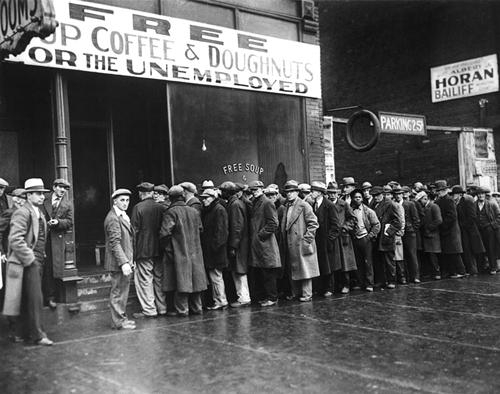Great Depression and World War II, 1929–45
The Great Depression (1929–39) was a severe economic downturn that began in the United States in the autumn of 1929 and continued until preparations for World War II (1939–45) began to revive the economy. Prior to the onset of the Depression, the 1920s had been characterized by economic prosperity, with then-presidential candidate Herbert Hoover predicting in 1928 that the United States was close to “the final triumph over poverty.” However within months of assuming the presidency in March 1929, Hoover (in office 1929–33) was facing dire economic circumstances, with millions of Americans unemployed and much of the nation's industry idle.
 Many factors contributed to the onset of the Great Depression. Among these was the decline of the agricultural sector. During World War I (1914–18) farmers borrowed heavily to bring more land into production and to take advantage of mechanized farm equipment, especially the tractor. However, the war ended before this new land and equipment could be put to full use. Farm prices fell when European demand for crops waned, leaving U.S. farmers with no way to pay their loans. Despite several federal measures to provide assistance, the agricultural sector could not overcome this setback, and farmers never shared in the general prosperity of the 1920s.
Many factors contributed to the onset of the Great Depression. Among these was the decline of the agricultural sector. During World War I (1914–18) farmers borrowed heavily to bring more land into production and to take advantage of mechanized farm equipment, especially the tractor. However, the war ended before this new land and equipment could be put to full use. Farm prices fell when European demand for crops waned, leaving U.S. farmers with no way to pay their loans. Despite several federal measures to provide assistance, the agricultural sector could not overcome this setback, and farmers never shared in the general prosperity of the 1920s.
Meanwhile, in manufacturing, the introduction of a wide range of new consumer products became emblematic of a decade of prosperity. These new goods, which included toasters, vacuum cleaners, and, not least, cars for working-class Americans, marked a shift from an economy based on the production of durable goods and urban infrastructure to one based on the manufacture and sale of consumer goods. As workers' wages rose, they were able to buy the many new goods on the market, which, in turn, increased company profits. Many workers also took advantage of new installment plans, thus going into debt to buy the new products. The expansion of industrial production and increased profits made stocks an attractive investment. As stock prices rose, the market attracted a flurry of investors. The market seemed to have an endless capacity for growth, and some Americans were lured into buying stock on margin—taking a loan with the promise to pay within a stipulated period, usually 30 days. If the stock increased in value during that time, the investor was able to repay the loan. Read more ..

 Many factors contributed to the onset of the Great Depression. Among these was the decline of the agricultural sector. During World War I (1914–18) farmers borrowed heavily to bring more land into production and to take advantage of mechanized farm equipment, especially the tractor. However, the war ended before this new land and equipment could be put to full use. Farm prices fell when European demand for crops waned, leaving U.S. farmers with no way to pay their loans. Despite several federal measures to provide assistance, the agricultural sector could not overcome this setback, and farmers never shared in the general prosperity of the 1920s.
Many factors contributed to the onset of the Great Depression. Among these was the decline of the agricultural sector. During World War I (1914–18) farmers borrowed heavily to bring more land into production and to take advantage of mechanized farm equipment, especially the tractor. However, the war ended before this new land and equipment could be put to full use. Farm prices fell when European demand for crops waned, leaving U.S. farmers with no way to pay their loans. Despite several federal measures to provide assistance, the agricultural sector could not overcome this setback, and farmers never shared in the general prosperity of the 1920s.